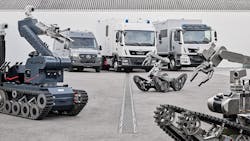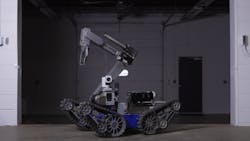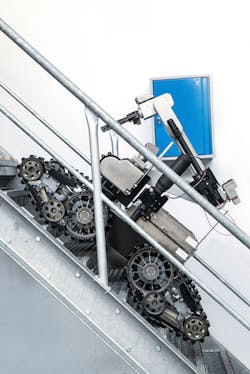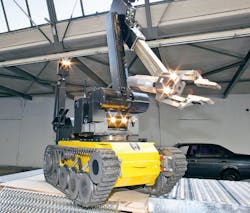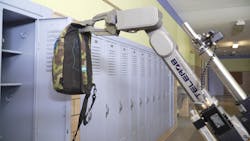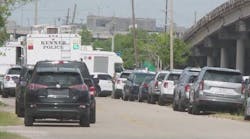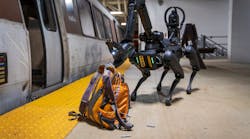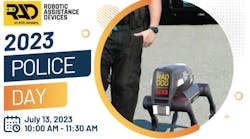Unmanned Aerial Vehicles are often referred to as “drones,” but as technology advances, Unmanned Ground Vehicles can also be added to the mix. Today’s tactical robots are much more advanced than their predecessors and give agencies an extra set of eyes—as well as hands—during high-risk situations.
Earlier this year, robotics systems company AeroVironment, which has long focused on technology in the sky with unmanned aircraft systems, acquired the German ground robotics company Telerob. The move signals a shift toward expanding the role of UGVs for law enforcement agencies when performing dangerous missions including explosive ordinance disposal (EOD), hazardous materials handling (HAZMAT) and chemical, biological, radiological and nuclear (CBRN) threat assessment.
At a recent press conference, AeroVironment introduced Telerob’s telemax and tEODor EVO robots into its own family, while also giving a glimpse into the advances in UGVs that agencies can expect to become part of their arsenal in the future. “UGVs for military and first responders to primarily counter explosive ordnance and IEDs has only been a first step over the years,” says Thomas Biehne, Managing Director of Telerob. “Nowadays, threat scenarios call for much more complex responses. Gathering information from various senders, processing them and ultimately providing the tools to neutralize resulting risks in a reliable and safe technology ecosystem makes the difference. Multi-domain networks of various unmanned vehicles and sensors allow for extended applications and much higher utility in broader markets; further on our way to reduce human exposure to dangerous situations and counter them increasingly from a safe distance.”Powerful suite of robots
Adam Jaroh, Product Line General Manager for Telerob in the U.S., highlighted the tEODor and telemax line of robots, stressing the importance of the six-degree of freedom manipulator, which allows the robots to grasp and lift objects at the direction of its operator.
“Over the years, working closely with our customers, we’ve continued to advance the technologies featured in the tEODor robot. This includes advanced camera systems, laser rangefinder in the gripper and advanced radio systems to provide a better communication network for the first responders,” he says. “Since the original launch of tEODor, we’ve continued to expand our product line with the telemax family of robots. This ruggedized series of platforms includes five UGVs that provide a common architecture and platform design while allowing customers to have scalable size for payload capacity, lift capacity and accessories and tools to complete their mission set.”
All of the robots operate off of Telerob’s Robo Command control station, which provides a multi-touch intuitive touchscreen with ergonomically designed joysticks and features the ability to create a secure wide area network communication system to the company’s IP mesh radios. The robots also include the Tool Center Point Control, which allows for complex manipulation through simplified user inputs and coordinates the movement of all rotational joints of the manipulator, allowing the operator to simply focus on the target, choose their direction and speed and move directly into that target like a human arm would. The robots also have the ability to store and use tools and accessories to complete specific jobs and missions.
“For the past 25 years, we’ve continued to work with bomb techs and operators around the world with a focus on delivering a superior user experience, performance and safety through innovation,” says Jaroh.UGVs in the field
Detective Jay Yelick has served with the Los Angeles County Sheriff’s Department for about 30 years and has spent the last 8 with the bomb squad. As a bomb technician, he has hand-on experience with Telerob’s robots and says that they have been invaluable to the job as his unit responds to around 30 to 40 calls per month.
“Our call response is pretty varied from suspicious packages to unknown items including hoax devices and illegally manufactured explosives and homemade laboratories, military ordinance response, suspected vehicle-borne IEDs or just suspicious vehicles and suspicious packages within vehicles, as well as in support of tactical operations for our SWAT team and hazardous environments.”
He recalled an instance where the bomb squad responded to a suspicious package discovered in front of a Planned Parenthood center. A typical response used to be to outfit a team member in a bomb suit, equip them with an X-ray and send them to make physical contact with the package to just develop a plan of action. “With a UGV, we can send a robot down there in a safe manner and they can exploit the package,” says Yelick. “Specifically, with the telemax, it doesn’t have the after-action bounce. The Tool Center Point Control is a fluid human-like maneuver with the manipulation of the arm and I was able to seamlessly retrieve a cutting tool from the tool bay, open up the box and then stow the tool and then have the gripper to exploit the items that were in the box and render the area safe and restore normalcy to that area long before we would have even had someone in a suit.”Yelick talked about the importance of the tool exchange feature in allowing his unit to utilize the robot in its full capabilities. “We have the fluid movement with the Tool Center Point Control with the manipulator arm, we can access a portal point or open up a package or unzip a backpack zipper and then grab a tool off the tool bay, use a tool to further exploit that package or disrupt it, and then we can stow that tool back into its tool bay and then still have full manipulation of the arm.”
He says that his unit uses the UGVs for more than just EOD and that often times in a tactical situation with the SWAT team, they will provide a static observation point using the robot’s cameras.“My response area for my unit is massive. It ranges from the high desert all the way to the beaches of southern California and 87 cities in between,” he says. “This particular robot obviously can be transported on the ground on a truck, but because of its size and portability, it can also be put onto a helicopter, and we can take it to one of the outlying islands that we serve or anywhere in our jurisdiction much more rapidly should we need to. Once on scene then we have that full suite of tools that we can use that are mountable onto the chassis itself, that are deployable downrange and it’s the tool center point control that gives us that fluid movement—that positive control over the arm—and a known result for certainty.”
